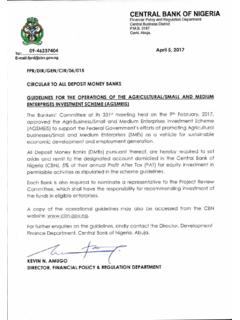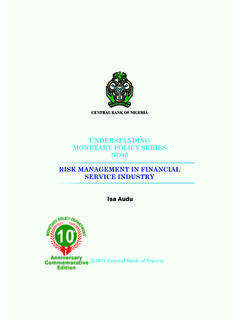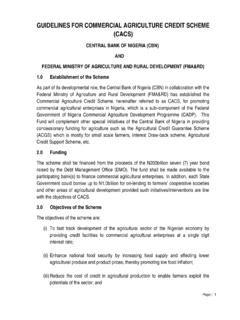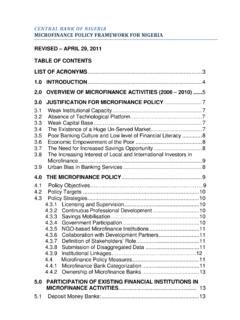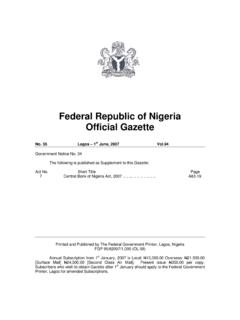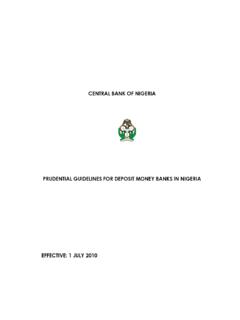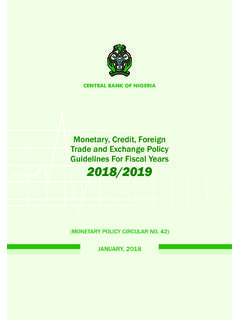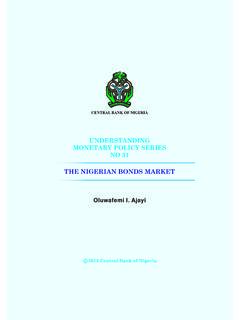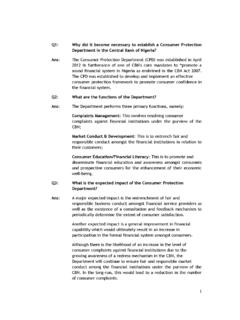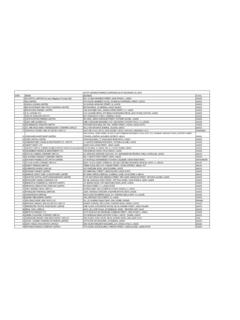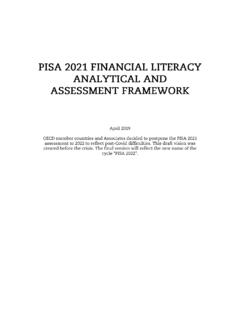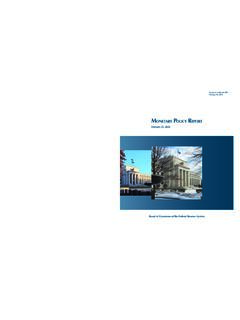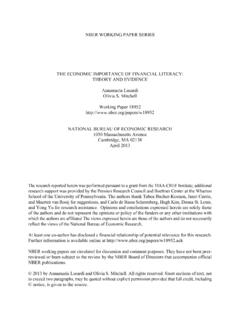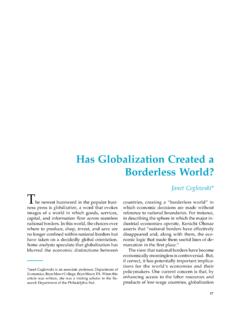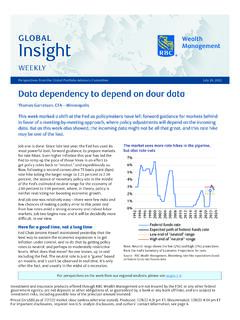Transcription of Financial Inclusion In Nigeria: Issues And Challenges
1 Occasional Paper No. 45. Financial Inclusion In Nigeria: Issues And Challenges U. Kama M. Adigun AL BANK OF NI. NTR GE. RI. CE A. CENTAL BANK OF NIGERIA. August 2013. Financial Inclusion In Nigeria: Issues And Challenges Copyright 2013. Central Bank of Nigeria 33 Tafawa Balewa Way Central Business District P. M. B. 0187, Garki Abuja, Nigeria Studies on topical Issues affecting the Nigerian Economy are published in order to communicate the results of empirical research carried out by the Bank to the public. In this regard, the findings, interpretation and conclusions expressed in the papers are entirely those of the authors and should not be attributed in any manner to the Central Bank of Nigeria or institutions to which they are affiliated.
2 The Central Bank of Nigeria encourages dissemination of its work. However, the materials in this publication are copyrighted. Request for permission to reproduce portions of it should be sent to the Director of Research, Research Department, Central Bank of Nigeria, Abuja. Financial Inclusion In Nigeria: Issues And Challenges CONTENTS. List of Tables .. iv List of Figures .. iv Acronyms .. iv Abstract .. 1. Introduction .. 2. Conceptual Issues and Relevance of Financial Inclusion .. 3. Conceptual Issues .. 3. Relevance of Financial Inclusion .. 5. Financial Inclusion in Selected Jurisdictions .. 7. Developed Economies .. 7. Emerging Economies India Malaysia and Brazil.
3 9. Middle East and North Africa (MENA) .. 12. African Experiences .. 13. Overview of Financial Inclusion in Nigeria .. 15. Past Efforts at Financial Inclusion in Nigeria .. 16. Recent Financial Sector Reforms and Financial Inclusion in Nigeria .. 20. Financial Stability Strategy 2020 (FSS2020) .. 20. Microfinance Policy .. 21. Non-Interet Banking .. 22. E-Banking Products and Electronic Payment System and Cashless Policy .. 23. Recent Developments on Financial Inclusion in Nigeria 26. Issues and Challenges .. 31. The Way Forward and Conclusion .. 34. The Way Forward .. 34. Conclusion .. 39. References .. 41. iii Financial Inclusion In Nigeria: Issues And Challenges List of Tables Table 1: Rural Banking Programme in Nigeria (1977-1983).
4 17. Table 2: Summary of Activities of People's Bank of Nigeria (1989-1994) .. 19. list of Figures Figure 1: Number of ATMs per 100,000 Adults in Selected Countries 23. Figure 2: Number of POS per 100,000 Adults in Selected Countries 24. Figure 3: Use of Financial Products in Nigeria .. 26. Figure 4: Total Population/ Financial Access .. 27. Figure 5: Geo-political Distribution of Unbanked Nigerians .. 28. Figure 6: Financial Access Among Female Population in Nigeria .. 28. Figure 7: Financial Access Among Male Population in Nigeria .. 29. Figure 8: % of Household with Access to a Bank Account in Selected Countries .. 30. LIST OF ACRONYMS. ATM Automated Teller Machine POS Point of Sale CGAP Consultative Group to Assist the Poor CFI Centre for Financial Inclusion MENA Middle East and North Africa ECA Europa and Central Asia LAC Latin America and Caribbean EAP East Asia and Pacific OECD Organisation for Economic Cooperation and Development AFI Alliance for Financial Inclusion PCC Plymouth City Council NERFUND National Economic Reconstruction Fund FEAP Family Economic Advancement Programme EFInA Enhancing Financial Innovation and Access N11 Next Eleven Emerging Economies/Countries KYC Know Your Customer iv Financial Inclusion In Nigeria.
5 Issues And Challenges Financial Inclusion IN NIGERIA: Issues AND Challenges . Abstract Financial Inclusion is a state where Financial services are delivered by a range of providers, mostly the private sector, to reach everyone who could use them. Specifically, it means a Financial system that serves as many people as possible in a country. In recent time, Financial Inclusion has assumed a critical development policy priority in many countries, particularly in developing economies. This paper reviewed experiences of other jurisdictions in the achievement of Financial Inclusion . More importantly, the various country experiences showed that, though Financial Inclusion may have become a general phenomenon, its nature, form and Challenges differ among jurisdictions and as such cannot be addressed by a single product or one size fit all approach.
6 Nations should therefore implement initiatives that take into consideration the peculiarities of their environments and most critically its local people. It further reviewed past and present efforts at promoting Financial Inclusion in Nigeria. Although gradual progress is being made to improve on Financial Inclusion , critical Challenges of low Financial literacy, inadequate infrastructural facilities as well as inadequate and inefficient technology- based facilities by Financial institutions, has limited the achievement of significant expansion in Financial Inclusion level in Nigeria. This study recommends a systematic approach that aligns responsibility and institutions among all stakeholders in the Financial Inclusion process to guarantee sustainability.
7 Key Words: Financial Inclusion , Financial Services, Poverty and Economic Growth & Development. JEL Classification: G20, G21, O16, O40, I30. 1. Financial Inclusion In Nigeria: Issues And Challenges INTRODUCTION. The principle of Financial Inclusion has assumed greater level of importance in recent times due to its perceived importance as a driver of economic growth. Giving access to the hundreds of millions of men and women (all over the world) who are presently excluded from Financial services would provide the possibilities for the creation of a large depository of savings, investable funds, investment and therefore global wealth generation.
8 In other words, access to Financial services, that are well suited for low-income earners promote enormous capital accumulation, credit creation and investment boom. Usually the low-income earners constitute the largest proportion of the population and so control enormous chunk of the economy's idle fund albeit held in small amounts in the hands of each of the several million members of this group. Harnessing and accumulating these resources provides a huge source of cheap long-term investable capital. Mehrotra et'al (2009), emphasised that access to Financial services allows the poor to save money outside the house safety, and helps in mitigating the risks that the poor faces as a result of economic shocks.
9 Hence, providing access to Financial services is increasingly becoming an area of concern for every policymaker for the obvious reason that it has far reaching economic and social implications. Financial Inclusion has therefore become an explicit strategy for accelerated economic growth and is considered to be critical for achieving inclusive growth in a country. This realisation, in the recent past, was the major impetus for the adoption of policies and measures aimed at growing global Financial Inclusion as a means of promoting world economic prosperity. Notwithstanding this global consensus, achieving pervasive Financial Inclusion has remained a global challenge with as much as per cent of adults worldwide being financially excluded (without access to Financial services).
10 The situation is even worse in the developing economies where some countries have as much as per cent Financial exclusion levels. The 2010 Financial survey by the Consultative Group to Assist the Poor 2. Financial Inclusion In Nigeria: Issues And Challenges (CGAP/World Bank), show that the figures in almost all economies in Sub- Saharan Africa were below this world average, while high-income countries were above it. Sub-Saharan Africa and South Asia are the regions with the lowest share of banked households. The report also indicated that the percentage of households having deposit accounts in a formal Financial institution varies greatly across countries, ranging from below per cent in the Democratic Republic of Congo and Afghanistan to about 100 per cent in Japan.
